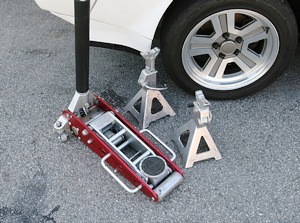When working on your Jaguar it is essential to make sure it is properly supported.
A Series III XJ6 weighs about 4100 lbs. You can't afford to take chances with your safety.
Firstly, you will want high quality, heavy duty jack stands. Do not buy the cheap, stamped sheet-metal type stands. Quality stands are only slighty more expensive than the low-grade models. Do not take chances here!
You will also want a good quality 2-ton (or higher) floor jack. No, it is not necessary to spend hundreds for a professional grade floor jack but do not be tempted by a "Brand-X" floor jack at a ridiculously low price from a third world nation.
Before lifting your Jag make sure the parking brake is on, the transmission is in "Park", and the wheel opposite of your jack point is blocked.
According to the Jaguar Service Manual the car may be lifted as follows:
To lift one front wheel place the cup of your floor jack under the front suspension lower control arm with a block of wood between the jack and the spring pan. The wood (use hardwood) disperses the load and prevents damage to the spring pan.
To lift one rear wheel place the cup of the jack at the outboard end of the rear suspension wishbone, again using a block of wood and taking care to avoid catching the hub carrier (large aluminum casting) or the grease nipple.
To lift the entire front end place your jack under the center of the front crossmember with a piece of wood in between. The cross member is the large structural piece under the engine and between the left and right lower control arms.
To lift the entire rear end place your jack under the rear suspension tie bar. This is the plate directly below the actual differential itself. And, yes, use a piece of wood between the jack and the tie bar.
(As you can see it will be helpful to accumulate some scraps of hardwood !)

Your jack stands should be placed immediately under or next to the four jacking pegs. The pegs are visable directly aft of the front tires and directly forward of the rear wheels. These pegs are mounted in a reinforced structural area. If your stands have a flat bar at the top, place them right next to the pegs. If they have a cup-type top, place them right under the pegs. Some Jag owners fabricate wooden spacers to securely engage the pegs and the jackstands.
If your Jag is rusty extreme caution is required as the jacking points and/or support pegs may be weakened from rust and not support the weight of the car. A bit rare, but it does happen in extreme cases. Please be careful.
Once up on stands you must now use your body weight to give the car several good shoves in all directions. If fate decrees that it must fall, now is the time... before you are underneath.
Some Jag owners leave the floor jack in a raised position under the car just for additional security... not a bad idea. Going one step further (no reason not to, right?) place a block of wood in the maw of the jack so if it does collapse the arm will only drop a few inches. At very least leave your floor jack close by. In the event that the car does fall your rescuer will be able to find the jack easily.
Which brings up another point: instruct your family members on usage of the floor jack! If the unthinkable happens they'll need to know what to do.
Addtionally, don't work alone! If a helper cannot be present at very least let someone know you are working on your car. The thought of being trapped under a car for hours before being discovered is gruesome.
If you are in doubt about jacking/supporting your car or ANY OTHER safety related issues...
PLEASE seek the assistance of an experienced helper.
















Want to leave a comment or ask the owner a question?
Sign in or register a new account — it's free